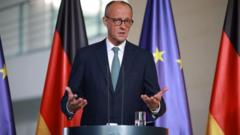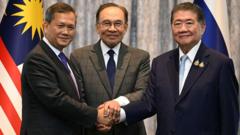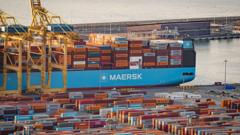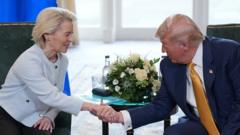In a recent press briefing, President Donald Trump announced that India could be subjected to tariffs as high as 25% if the two nations do not finalize their trade deal by the upcoming deadline of August 1. This warning underscores the precarious nature of the ongoing negotiations between the United States and India, which have seen fluctuating levels of optimism from both sides. Trump remarked on India's previous tariff rates, labeling the country as a "tariff king" and stating, "You just can't do that" under his administration.
Trump Warns India of Potential 25% Tariffs if Trade Deal Not Finalized
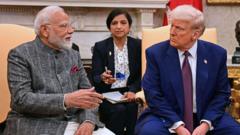
Trump Warns India of Potential 25% Tariffs if Trade Deal Not Finalized
President Trump indicated that India might face substantial tariffs unless a trade agreement is reached by August 1st, highlighting tensions in US-India trade relations.
For several months, US and Indian officials have been working on a trade agreement, with recent days witnessing mixed signals about the progress. US Trade Representative Jamieson Greer acknowledged discussions have been constructive, yet he reiterated the long-standing protectionist stance of India's trade policy. He emphasized the importance of opening markets and reducing trade barriers.
Key sectors causing friction in negotiations include agriculture and dairy, where the US has long sought more access to India's largely protected markets. Indian Commerce Minister Piyush Goyal has emphasized the need to safeguard the interests of small farmers, highlighting the agricultural industry's sensitivity in India. Despite challenges, Goyal expressed optimism about achieving a fruitful agreement with Washington soon.
In prior developments, Trump announced increased tariff rates of up to 27% on Indian goods earlier this year but opted to pause those rates while negotiations continued. The stakes remain high, as the bilateral trade between the two countries reached $190 billion in 2024, with plans to elevate that figure to $500 billion. Currently, the US holds a significant trade deficit with India, a situation Trump is eager to address.
As these discussions unfold, the Indian government has already begun reducing tariffs on select products, but the overall dynamics of tariff policies continue to be a key point of contention. The situation remains fluid as both countries seek a resolution before the looming deadline.
Key sectors causing friction in negotiations include agriculture and dairy, where the US has long sought more access to India's largely protected markets. Indian Commerce Minister Piyush Goyal has emphasized the need to safeguard the interests of small farmers, highlighting the agricultural industry's sensitivity in India. Despite challenges, Goyal expressed optimism about achieving a fruitful agreement with Washington soon.
In prior developments, Trump announced increased tariff rates of up to 27% on Indian goods earlier this year but opted to pause those rates while negotiations continued. The stakes remain high, as the bilateral trade between the two countries reached $190 billion in 2024, with plans to elevate that figure to $500 billion. Currently, the US holds a significant trade deficit with India, a situation Trump is eager to address.
As these discussions unfold, the Indian government has already begun reducing tariffs on select products, but the overall dynamics of tariff policies continue to be a key point of contention. The situation remains fluid as both countries seek a resolution before the looming deadline.








